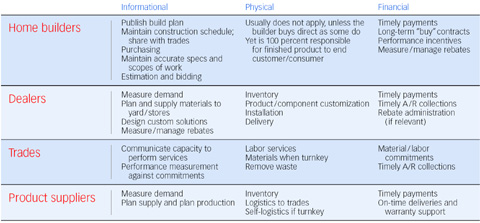- What is our company’s business definition in terms of the following opportunities? Providing materials and supplies? Building components? Installed sales and after-service? Developing builder/trade solutions? Providing information system solutions? Being there for customers when they need assistance (rapid service)?
- How does our company differentiate? Best inventory choice or access? Best prices? Best people or solutions? Market expertise? Market coverage? Product/services expertise?
- What are the trends management must address to set our company apart and ahead? Pricing models? Technology? Personnel and expertise? Market breadth and depth? Market coverage?
- What are acceptable or desired financial targets? Revenue growth? Profit margins? Net income margins? ROIC? Inventory turns? Length of customer contracts or commitments?
Information Systems
- What information does each stakeholder group in our company need to achieve desired business goals? Customer insight and information? Supplier/vendor insight and information? Profitability at various levels (business; unit; line of business; customer; service)? Employee productivity and performance? Yard inventory? Unfulfilled orders?
- How does this information need to be accessed and used? Reports? Query-based analyses? Easy-to-access databases? Handheld devices?
- How important is it to communicate outside of the organization, and how? With suppliers? With customers? With other partners/stakeholders and communities?
- What role might business intelligence play at the company? Advanced insight into trends? Customer intelligence? Margin/profitability intelligence? Competitive intelligence and pricing analyses?
- What is the proper role of Internet-based applications? Capture builder demand information? Understand vendor/supplier capability to deliver or provide materials? Communicate order status?
Communicate installation status? Invoicing, collections and status? Accept orders online?
What It’s All About Whether you conduct a supply chain assessment with these questions on your own or with the help of a third-party facilitator or consultant, you need to drive toward creating a Supply Chain Vision, one-to-three-year and five-year goals, and then take tactical steps to achieve those goals. It is often crucial to survey your customers’ needs and wants, to ensure that your Supply Chain Vision is synchronized with the service levels your customers desire or might expect. Like an annual business strategy, your supply chain management initiative should be 1) easy to explain to the organization, 2) measurable, and 3) tied to financial and operating goals. For instance, to support growth and margin objectives, your business might call for 33 percent of all new revenues to consist of installed sales, with significant implications for the order information you collect, the customer expectations you set, how you measure on-time performance and quality, and naturally what systems you may need to enhance or add to grow this side of the business with fewer labor resources than a manual approach would require.
SCM is about running a better business for better customer outcomes. Builders have begun the adoption process. With industry slowdown upon us and demand volatility at record highs, there is no better time for dealers to assess operational excellence in all five areas of the supply chain: strategic, operational, tactical, organization, and information systems. Can you afford to manage the turbulent times ahead without SCM? —Luis F. Solis is CEO and president of Symbius Corp. (www.symbius.com) and GroupSystems Corp. (www.groupsystems.com), and is a well-recognized business leader and venture investor in collaboration technology, supply chain, and global logistics management.
Editor’s Note: For more information on supply chain models, see The Building Blocks of Supply Chain Management, page 38.

